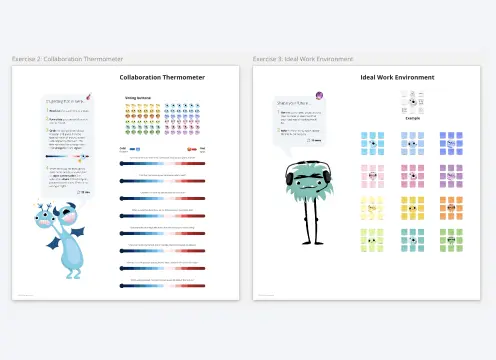Team norms are extremely critical to define, ensuring the team has a shared operational compass. We used this board to run a 2-hour virtual workshop to help one of our newly formed teams build deeper personal connections and define their team norms.
By structuring the board with Personal Workspaces around a Main Stage, you can give your team space to create their profiles and brainstorm norms.
How to use Team Norms + Personal Profiles
Step 1: Reflect individually on working in distributed teams.
What we did: I asked each person to write on sticky notes all of the practices that have enabled effective distributed work and those that have hindered it. Next I asked the team to identify the essential principles they felt critical when working on a distributed team.
Step 2: Group and vote on principles.
What we did: The team moved their stickies up to the main stage and began to organize them into themes. I had the group vote on the practices and principles that resonated with them the most. We then organized the top voted ones and had an open discussion about each one. Organize and discuss the top voted stickies. I asked different members of the team what each means to them? It’s also important to clarify any inconsistencies in understanding.
Step 3: Wrap up and next steps.
What we did: One of our team members volunteered to take the lead on drafting a polished version of the team’s norms. She drafted a working document and shared with the broader team for feedback and validation. The team plans to review it on a regular cadence, as norms will naturally evolve.
The Outcomes
After a one-hour guided session, we were able to create an agreed upon set of norms that the team can always refer back to and tweak if the team’s way of working evolves. The document covers everything from calendaring practices to hours of operation to meeting rituals.
For a step-by-step playbook with examples on how to run this type of workshop, check out these posts:
Watch the video

Danny Carvajal
Head of Product Enablement @ Samsung NEXT
Team Coach, Servant Leader, Facilitator, and Workshop Ninja.
Categories
Similar templates
Meet the Team Template

Meet the Team Template
A Meet the Team page is the best way to introduce each member of the team or organizational leaders. It includes profile pictures and bios with their work experience, achievements, and social media links. The Meet the Team Template helps you design a page that genuinely reflects your team.
User Persona Template

User Persona Template
A user persona is a tool for representing and summarizing a target audience for your product or service that you have researched or observed. Whether you’re in content marketing, product marketing, design, or sales, you operate with a target in mind. Maybe it’s your customer or prospect. Maybe it’s someone who will benefit from your product or service. Usually, it’s a whole collection of personalities and needs that intersect in interesting ways. By distilling your knowledge about a user, you create a model for the person you hope to target: this is a persona.
The Way We Work
Meet the Team Template

Meet the Team Template
A Meet the Team page is the best way to introduce each member of the team or organizational leaders. It includes profile pictures and bios with their work experience, achievements, and social media links. The Meet the Team Template helps you design a page that genuinely reflects your team.
User Persona Template

User Persona Template
A user persona is a tool for representing and summarizing a target audience for your product or service that you have researched or observed. Whether you’re in content marketing, product marketing, design, or sales, you operate with a target in mind. Maybe it’s your customer or prospect. Maybe it’s someone who will benefit from your product or service. Usually, it’s a whole collection of personalities and needs that intersect in interesting ways. By distilling your knowledge about a user, you create a model for the person you hope to target: this is a persona.
